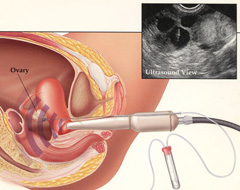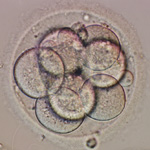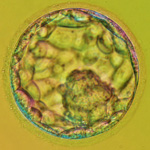IVF facts
- In vitro fertilization (IVF) combines a woman’s eggs and a man’s sperm in a laboratory to produce an embryo. The embryo is then implanted in to the woman’s womb (uterus) for conception.
- It has the highest per cycle success rates compared to other fertility treatments, resulting in more than 72,000 IVF babies in the United States in just one year (data from 2017).
- IVF is successful because the process controls fertilization in a laboratory environment that increases contact of eggs and sperm compared to the contact that occurs naturally.
- In vitro fertilization also allows for genetic testing of embryos to screen their chromosomes, allowing for transfer of only genetically balanced (euploid) embryos and/or gender selection.
- Those who might consider IVF include women with ovulation problems or anatomical issues such as blocked fallopian tubes, men with poor sperm quality, same sex couples (in conjunction with egg or sperm donation) or couples with an unexplained infertility diagnosis.
- IVF is not needed for everyone having trouble conceiving. Evaluation of the couple or individual by a fertility specialist along with a thorough discussion are essential to determining the best course of fertility treatment.
Contact
Devoted to you, dedicated to your success
Contact Dallas IVF today to set up an appointment to discuss your fertility options. Now offering telemedicine virtual consults.
Call us: (214) 225-2057
How IVF (in vitro fertilization) treats infertility
In vitro fertilization (IVF) helps overcome certain conditions in both the male and female reproductive systems that cause infertility. “In vitro” is Latin for “in glass,” meaning fertilization occurs in a glass container in the lab.
IVF utilizes laboratory and other assisted reproductive techniques to increase the chance of sperm fertilizing an egg to create an embryo (see The IVF process below).
Infertility is when natural conception is compromised due to structural problems or imbalances in the mix of reproductive hormones in the male, the female or both (see Is IVF right for me? below).
By taking this aspect of reproduction into the lab, fertility specialists can give people the chance for a baby that wouldn’t be possible or very unlikely otherwise.
It allows fertility specialists to combine more sperm with more eggs than is possible naturally, increasing chances of creating a healthy embryo that can be implanted for pregnancy.
Fresh vs. frozen IVF cycle
Cryopreservation of eggs (egg freezing) and embryos (fertilized eggs) allows for easier and quicker future IVF treatment in what’s known as a frozen IVF cycle. In comparison, a fresh IVF cycle involves retrieving the egg, fertilizing it and implanting the embryo at its proper stage of development.
Common questions about IVF
- Who needs it? Women with ovulation or reproductive structural problems, men with poor sperm or structural problems, and LGBTQ+ individuals.
- How does it work? Combines sperm and eggs in a lab for better chance at fertilization and a resulting embryo.
- What are the chances for IVF success? 30% per try, depending on the age and health of the male and female partners.
- What are the drawbacks? IVF is not guaranteed to work, it involves a lot of time and is more expensive than less invasive fertility treatments.
IVF success rates
Although IVF is not a cure-all for infertility and may not be right for every patient, it provides the best fertility treatment success rate for many couples and individuals experiencing infertility.
The Society for Assisted Reproductive Technology (SART) reports that in the U.S. the average chance of taking home a baby from a single IVF cycle is 30%. That’s up from 5% 30 years ago.
There are many variables in this treatment. Factors affecting success include:
- The reason for infertility.
- The woman’s age.
- Quality and quantity of a woman’s eggs (ovarian reserve).
- Quality and quantity of a man’s sperm.
- Previous reproductive health issues and structural abnormalities.
- The health and viability of embryos created through IVF.
- Lifestyle factors such as smoking and obesity that harm fertility.
Is IVF right for me?
IVF often can work around a cause of infertility in both men and women. It is also an option for same-sex couples, LGBTQIA+ individuals and single patients in need of reproductive assistance. In vitro fertilization may also be used after other fertility treatments have failed.
Below are reasons a man, woman or couple may need in vitro fertilization.
- Male infertility factors, such as men producing no sperm, sperm of poor quality or sperm with poor movement (motility). Additionally, men with structural blockages or other conditions that prevent delivery of sperm.
- Women who have problems ovulating, including anovulation (no ovulation). Sometimes ovaries have suffered from injuries or tumors that inhibit their abilities to produce eggs. Taking certain medications for other conditions can inadvertently stop the ovulation process.
- Women with low ovarian reserve, meaning few eggs of good quality (often associated with age-related infertility in women age 35 or older).
- Women with structural issues, most commonly blocked fallopian tubes. This can prevent sperm from reaching the egg in the fallopian tube for fertilization and can prevent a subsequent embryo from traveling to the uterus for pregnancy. In most cases, fallopian tube damage or blockage is caused by chronic inflammation of the fallopian tubes due to a sexually transmitted infection such as chlamydia.
- Women with uterine fibroids or endometriosis, a condition in which the endometrium tissue normally found inside the uterus is displaced outside the uterus throughout the pelvic cavity. Both conditions can cause infertility.
- Men, women or both partners with genetic conditions that can be passed on to a child.
- Couples or individuals who have a diagnosis of unexplained infertility, meaning no cause can be identified.
- Couples or women who have experienced recurrent miscarriages.
- Women with polycystic ovary syndrome (PCOS).
- Desire to genetically test embryos for euploidy or gender.
IVF and egg/sperm donation
Women with poor quality eggs can also consider an egg donor to use in IVF. The resulting child will not have the mother’s genes but the mother carries the pregnancy and will deliver the child. Similarly, men with poor quality sperm can select to use donor sperm.
The IVF process
So, what happens during IVF to make it such a game changer for many couples and individuals? The basic steps of IVF follow.
Ovulation induction
Whereas a woman naturally releases one egg a month for possible fertilization, during IVF a woman takes medications, termed gonadotropins and including follicle stimulating hormones, to increase her ovaries’ mature egg output significantly. These are administered by injection at home daily over a period of a few weeks. This allows a fertility doctor to retrieve a higher number of eggs for the IVF process.
Once the eggs are of a mature size, as determined through office monitoring, the patient administers a “trigger” injection of either hCG (human chorionic gonadotropin) or lupron. The trigger injection helps mature the eggs and prepare them for the retrieval.
Egg retrieval

Approximately 36 hours after the trigger injection, egg retrieval takes place on an outpatient basis at our surgery center. With the patient under anesthesia, the fertility specialist retrieves multiple eggs from the woman’s ovary using a thin needle attached to the side of an ultrasound probe. An embryologist evaluates them for quality.
A typical egg retrieval lasts about 10 to 15 minutes, and the patient is often discharged about an hour later. The eggs can be frozen to use in the future or fertilized in the lab right after retrieval.
Introducing sperm for fertilization

The man (or donor) provides a sperm sample, which is treated in the lab and then combined with the woman’s eggs in vitro (in a lab dish) overnight in an incubator. If certain conditions exist impeding the sperm’s ability to reach and penetrate an egg, the sperm can be injected directly into the egg to assist fertilization in a process known as intracytoplasmic sperm injection (ICSI). ICSI is often used when male infertility is an issue.
Embryo preparation
Each successful fertilization of an egg creates an embryo. The embryo begins as a single cell and must then divide. Unhealthy embryos often stop dividing. The single cell splits into two cells then splits further. On the third day following an egg retrieval, most healthy embryos are at the 8-cell stage. On day-5, embryos should be at, or about, the blastocyst stage, which contains about a 100 cells and is the ideal stage for implantation.
|
|
|
|
The embryos created in an IVF cycle are evaluated, and viable (healthy) embryos are then selected for implantation in a fresh IVF cycle, or frozen for future use (embryos can be frozen at different stages of development). Due to potential genetic issues in the embryo that could prevent successful pregnancy or result in birth defects in a child, genetic testing of the embryos may also be recommended before transferring the embryo.
Embryo implantation & elective single embryo transfer (eSET)
If doing a fresh IVF cycle, the embryo transfer (implantation in the uterus) will occur five days after egg retrieval and fertilization, once the embryo has matured.
If doing a frozen embryo transfer cycle, the frozen embryo is either implanted soon after the woman has her next period after the egg retrieval or is used in a future IVF procedure.
Pregnancy occurs when the embryo attaches to the lining of the uterus. A fertility specialist may recommend assisted hatching, a procedure to help the embryo implant in the uterus.
The goal of fertility treatments is always the birth of a single, healthy child in order to avoid increased risks of medical complications for mother and baby that come with a multiple pregnancy (twins or more). Whenever possible, we encourage the couple or individual to choose to implant only one healthy embryo, which is known as elective single embryo transfer.
IVF risks and considerations
A fertility specialist will discuss all aspects of IVF with each patient, including:
- The complexity of the procedure.
- The time it takes.
- The medications involved.
- The cost of IVF.
- Considerations for stress through treatment and what happens if treatment doesn’t work.
All medical procedures involve risks, such as blood loss, tissue damage and pain. In vitro fertilization carries the following specific risks.
- The chance of a multiple pregnancy, which has health risks for mother and children.
- Ovulation hyperstimulation syndrome from medications, which is generally a short-term discomfort but can become a serious health issue.
- An ectopic pregnancy, which is when the embryo implants outside the womb.
- Damage to eggs, sperm or embryos during the various procedures.


